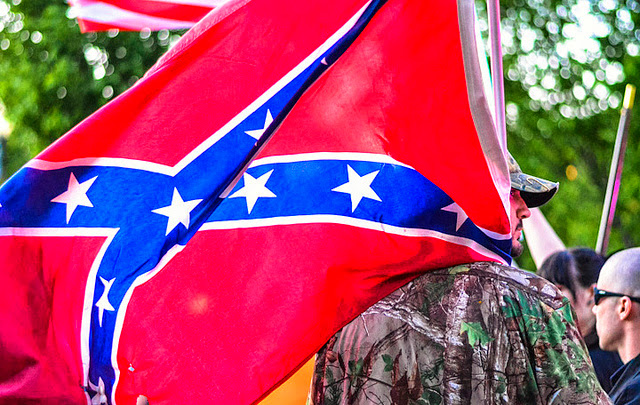Sometimes accidents of timing reveal what is no accident. The news media was preoccupied with two stories this past Monday: the letter that 47 Republican senators sent to Iranian leaders warning them that any agreement signed by the President might not outlast his term, and the outrage over footage of an Oklahoma fraternity singing a racist song that invoked lynching.
That fraternity was a chapter of the ΣΑΕ, whose website continues to note that, “of all existing national social fraternities today, Sigma Alpha Epsilon is the only national fraternity founded in the antebellum South.” This account of ΣΑΕ’s history goes on to explain that, because it was “founded in a time of intense sectional feeling”, the organization initially “confined its growth to the southern states,” adding, to emphasize the implications of these origins, that “the fraternity had fewer than 400 members when the Civil War began. Of those, 369 went to war for the Confederate States and seven for the Union Army.” To be fair, ΣΑΕ’s national office issued a swift denunciation of its University of Oklahoma chapter and has a prominent link on its home page to a statement explaining why it supports the university administration’s severe punishment of the chapter, including the expulsion of two members. But history is not easily brushed aside. The fact remains that, of all the fraternities in American higher education, ΣΑΕ is the only one that has proudly declared its ties to the Confederacy.
Of the 47 senators who signed the controversial letter, 18 represent states that seceded from the Union at the start of the Civil War. Most of the rest hail from places in the West and Southwest that did not achieve statehood until after the Confederacy’s defeat, including both senators from Oklahoma. While the number of “red states” varies from one election to the next, there is no denying that a sturdy coalition now links the more libertarian portions of the country west of the Mississippi River — the region from which Arizona’s Barry Goldwater drew his greatest support during his 1964 run for the White House — with those where slavery was most significant. The legacy of antebellum hostility to the Union, which remains strong throughout the former Confederacy, has proven a potent accelerant to the long-standing antipathy towards Washington D.C. in those states, such as Nevada, Utah and Idaho, where the greatest percentage of land is controlled by Federal agencies.
Whatever the historical differences between these two portions of the United States — for nearly a century, most Southerners wouldn’t vote for Republicans on principle, because they came from the party of Abraham Lincoln — they are now becoming more and more alike, united by fundamentalist Christianity, opposition to labor unions, promotion of the “Sun Belt” lifestyle and a firm conviction that the increasingly multicultural, cosmopolitan values communicated by the coastal elites will destroy the things that made America great. And, whether shouted out loud or whispered into someone’s ear, one of those things usually turns out to be white supremacy.
As disappointing as Barack Obama’s years in the Oval Office have been to the voters who saw him in 2008 as a beacon of hope, not to mention to all those people around the world who were eager to have a President they could trust, it is crucial to remember that many of his failures are the direct result of a political environment in which everyone from members of Congress to Joe the Plumber have openly misrepresented and disrespected him because he doesn’t fit their image of a leader. No matter how close his actions have hewed to the center, no matter how hard he has tried to project an aura of reasonableness, he will remain for them a firebrand “socialist” from a foreign land simply because he lacks a white name and a white face. From the minute he beat John McCain, some of these people felt empowered to attack him with openly racist language, as a survey of social media from the period preceding his inauguration makes clear. But a great many more, while not comfortable with such public discrimination, have found ways to express the same views in more private circles.
All it takes to register this distressing fact is to spend some time in the places where conservatives congregate, for it is certain that you will soon hear denunciations of Obama for pursuing more or less the same policies that his predecessor George W. Bush did, as well as even greater outrage for the few areas in which he has pursued a different course. Some of these critics will specifically target his skin color. But it is more common to hear a more subtle version of the same polemics, in which the President is derided for not being sufficiently American. It doesn’t matter to them that his grandparents were from Kansas or that he grew up in Hawaii after it achieved statehood. In their minds, he can never pass the test of true citizenship.
Perhaps it is another accident of timing that the 47 senators sent their letter to Iranian leaders in the immediate wake of the fiftieth anniversary of the “Bloody Sunday” in Selma, Alabama, where Obama delivered one of the best speeches in a career defined by his speechmaking. Speaking of the marchers who bravely set out to cross the Edmund Pettus bridge on that day in 1965 — named, it should be noted, for an important figure in the Klu Klux Klan — he declared that, “as we commemorate their achievement, we are well-served to remember that at the time of the marches, many in power condemned rather than praised them. Back then, they were called Communists, half-breeds, outside agitators, sexual and moral degenerates, and worse – everything but the name their parents gave them. Their faith was questioned. Their lives were threatened. Their patriotism was challenged. And yet, what could be more American than what happened in this place?”
Obama is no Martin Luther King Jr. Nor can he compare with Congressman John Lewis, who was there with King fifty years ago. But he is connected with those great men by the simple fact that he too is often called by everything but the name his parents gave him. When he asked, “What could be more American?” Obama was symbolically linking past and present, implying that his Presidency is in some sense the outcome of what transpired in Selma in 1965. Although this may seem like a self-serving assessment, it also contains a great deal of truth. Indeed, it’s not too much of a stretch to perceive a correlation between the violence meted out against the marchers on “Bloody Sunday” and the battering the President has taken as the most visible embodiment of what the Civil Rights Movement achieved. In both cases, the ire of racists was provoked when people of color refused to stay in the place assigned to them — a subservient, marginal one — within the white supremacist imaginary.
And that brings us back to the racist chant by the University of Oklahoma fraternity: “There will never be a nigger in ΣΑΕ. You can hang him from a tree, but he can never sign with me.” Understandably, much of the attention in the immediate aftermath of the incident focused on the horrific reference to lynching. But it’s crucial to note that this threat of violence is bound up with a declaration of exclusiveness. It is a song of segregation, implicitly defying all of the efforts made at American universities to promote diversity. Although it is impossible to know for sure, there is a very good chance that the fraternity members in the video don’t think of themselves as particularly racist and would, if pressed, state their affection for certain aspects of black culture. They were just repeating words that, despite what the national ΣΑΕ organization would like people to think, have been passed down, if secretly, for generations. After all, the idea that certain institutions — including political ones — need to be set aside only for white people was largely take for granted from the early years of Reconstruction through the 1950s, when the Civil Rights Movement forced people throughout the South and many other places in the United States — even Berkeley, California had neighborhoods where blacks were strongly discouraged from living — to justify their position.
As the past six years have made painfully clear, a great many white Americans did not transcend their racist impulses so much as find a way to redirect them towards more defensible forms of prejudice. The conviction that the President is a socialist, a fascist or a Muslim — and possibly not even a citizen — provides cover for an ideology whose principal concern is maintaining white supremacy. By sending their letter to Iranian leaders, the 47 Republican Senators confirmed that they were willing to stand with those constituents, even though it meant undermining the Presidency, who are either unable or unwilling to accept someone like Barack Obama as their leader. The letter’s message, basically, is that he should not have been allowed in the White House to begin with and will therefore see all the work he did there erased at the earliest possible opportunity.
The rapid and forceful condemnation of the University of Oklahoma ΣΑΕ chapter is an encouraging sign. So is the fact that The New York Daily News, by no means the United States’ most progressive newspaper, devoted its cover on Monday to declaring the 47 Senators “TRAITORS”. But no matter how much short-term progress is made in addressing attacks on African-Americans, the President included, the history that motivated these ugly incidents will not go away. Nor will the trends that made them more likely to go public. If we truly wish to honor the legacy of the Civil Rights Movement, we need to do more than commemorate its most impressive accomplishments. As more and more of them come under attack by conservatives who argue — and sometimes even believe — that systemic racial discrimination is no longer a problem in the United States, even while mobilizing public opinion in ways that belie that claim, we need to make the connections they wish to conceal, showing over and over and over how the specter of white supremacy continues to haunt American social and political discourse.
Lead photograph courtesy of Cool Revolution. Published under a Creative Commons license. Second photograph courtesy of the author.






